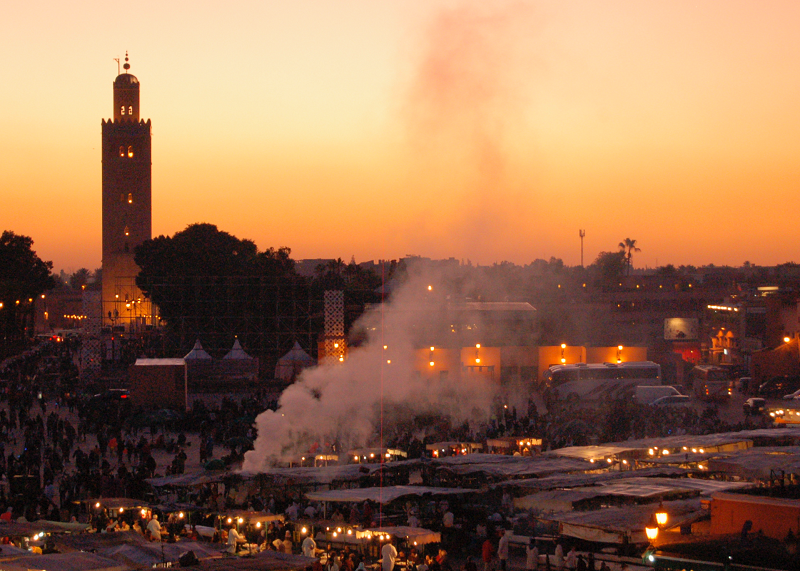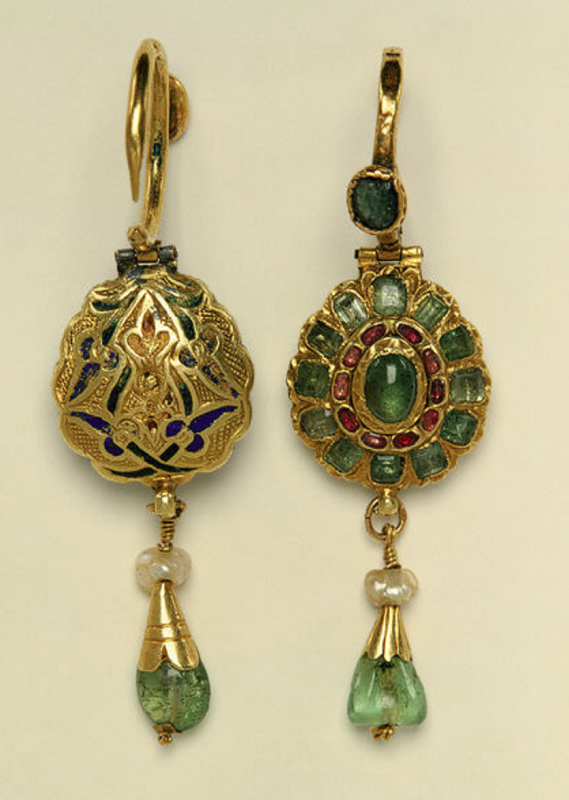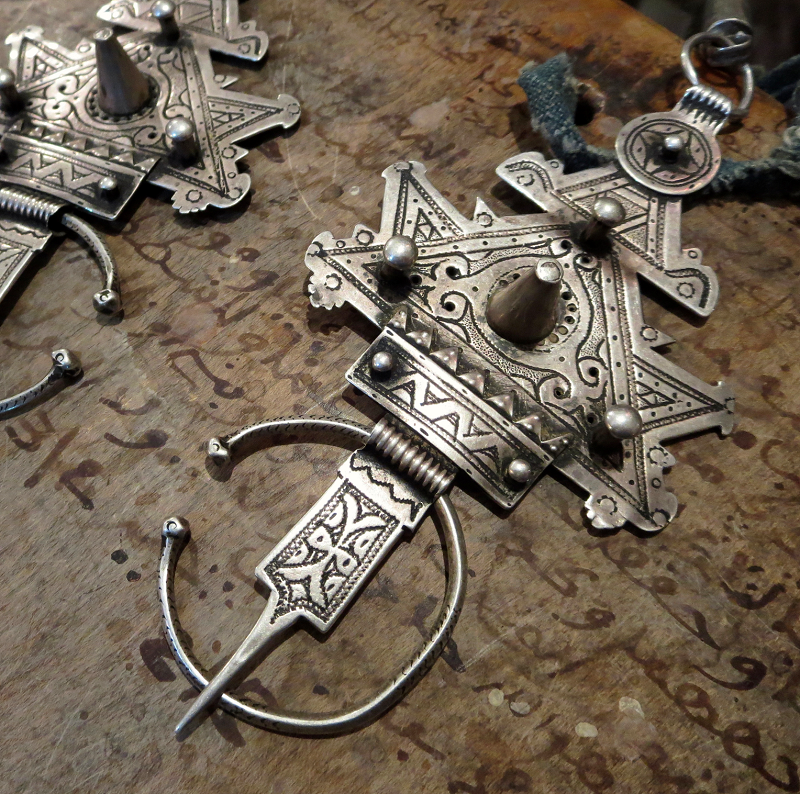We are continuing our series on jewellery with a focus on the jewellery traditions of various countries in North Africa and South West Asia. These jewellery traditions go further back in history than the geographical borders we know today, and of course, one country may be home to several cultural traditions. Both the historical context and the cultural heritage of a variety of peoples are visible in the jewellery worn, and we hope to introduce this wider scope of adornment and dress to you. In this post, we are looking at the long history of jewellery in
Morocco.
 Shell beads from Bizmoune Cave. Photo: A. Bouzouggar, INSAP, Morocco
Shell beads from Bizmoune Cave. Photo: A. Bouzouggar, INSAP, MoroccoThe oldest shell beads
Morocco is located on the western shore of North Africa. It connects Europe and Africa: the narrow Street of Gibraltar and the vast network of Saharan caravan routes enabled trade with the wider world. The oldest adornment found in Morocco was excavated in the Cave of the Pigeons, near Taforalt in the east of the country, where shell beads dating as far back as 82,000 years ago were found. The shells to create these beads were collected on purpose on the coast and then perforated. A study of these perforations shows that the beads have been worn strung on a cord, and what is even more remarkable is that some of the shells show traces of red colour. They may have been worn directly on something dyed with red
ochre
Ochre: (Greek: ōkhra – Yellow Ochre), is a natural earth pigment that ranges in colour from yellow to red-brown, often used in art and decoration. , which caused the colour to transfer onto the beads. Here, jewellery studies possibly reveal the presence of body aesthetics in the deep past. Even older beads were found in Bizmoune Cave, near Essaouira on the Atlantic coast. Here, 33 shell beads were excavated dating back to 142,000 years ago. These as well show signs of red
ochre
Ochre: (Greek: ōkhra – Yellow Ochre), is a natural earth pigment that ranges in colour from yellow to red-brown, often used in art and decoration. and intentional perforation, underscoring the intrinsic human need to communicate through adornment.
 Djemaa al-Fna in Marrakech at dusk. Marrakech was founded in the Middle Ages. Image: Sigrid van Roode
Djemaa al-Fna in Marrakech at dusk. Marrakech was founded in the Middle Ages. Image: Sigrid van RoodeMedieval networks
Due to its strategic location, western North Africa formed the stage for many power struggles. During the Arab expansions in the 7
th and 8
th centuries, the indigenous Amazigh territories were colonised, as was the south of the Iberian Peninsula. One of the cities founded by Arab conquerors in Morocco was al-Basra. Here, excavations have brought to light material hints at the ongoing unrest after the Arab conquests: during the 10
th century, someone buried a small treasure of silver coins, gold and glass beads in the hope of returning to pick it up later. Analysis of the glass beads has revealed the wide network in which al-Basra functioned. Some of the glass came from North Africa and Southwest Asia, but notably also from Europe, where glass bead-making had taken a flight during the early Middle Ages.
The city of Sijilmasa, in the oasis of Tafilalet, formed an important trading hub for more than six centuries. From here, trade expeditions to the African kingdoms such as Ghana and Mali were launched to obtain gold: the long trade routed through the Sahara, as they had existed for millennia, continued to provide access to the rest of the African continent.
The Amazigh empires
West African gold was minted into dinars around the 11
th century by the Amazigh dynasty of the Almoravid, whose control over Sijilmasa formed a stronghold in their expansion. The Almoravid founded the city of Marrakech as their capital, rebuilt other places such as al-Basra, and took control of the south of the Iberian Peninsula as well. Sijilmasa was important for another reason as well: in the vicinity, silver mines were discovered, from which silver could be extracted to mint silver dirhams. Western North Africa continued to exert a profound influence on the Mediterranean and Western Europe. In the 12
th century, Amazigh tribes in the High
Atlas
Atlas: (Arabic and Aramaic: atlas – silk; from Greek: Atlas – Character from Greek mythology Synonym: adras, ikat, abr), a resist dyeing technique that involves tying and dyeing yarns or threads before weaving, resulting in a distinct pattern. With strong traditions sporadically across the globe it probably originated independently around the world. Aṭlas: (Latin: Atticus Atlas
Atlas: (Arabic and Aramaic: atlas – silk; from Greek: Atlas – Character from Greek mythology Synonym: adras, ikat, abr), a resist dyeing technique that involves tying and dyeing yarns or threads before weaving, resulting in a distinct pattern. With strong traditions sporadically across the globe it probably originated independently around the world. – a large silk producing moth; from Greek: Atlas
Atlas: (Arabic and Aramaic: atlas – silk; from Greek: Atlas – Character from Greek mythology Synonym: adras, ikat, abr), a resist dyeing technique that involves tying and dyeing yarns or threads before weaving, resulting in a distinct pattern. With strong traditions sporadically across the globe it probably originated independently around the world. – character from Greek mythology; Synonym: harir), common term for silk in the Arab world especially the Levant.
developed a powerful empire that would later be known as the Almohad dynasty. The Almohads ruled over much of North Africa as well as the Mediterranean and parts of Western Europe and structured their rule along the old Amazigh tribal federation systems that had existed for centuries. The stability provided by the Almohad empire is reflected in material culture: ceramics and textiles were much prized in Italy, while silver dirhams minted by the Almohad dynasty remained accepted currency in western Europe up until the 16
th century.
 Earring in gold, enamel, emeralds, rubies and pearls. Likely made in Fez
Earring in gold, enamel, emeralds, rubies and pearls. Likely made in Fez
Fez: (Ottoman Turkish: fes
Fes: (synonyms: tarboush, tarbooch, tarboosh, tarbush, chachia, chechia, fez), generally red cylindrical men's felt cap with tassel. Also known as Fez after the city famous for its production in Morocco. The term is also used to denote the tassel, a bundle of suspended threads.
boyası - madder to Arabic Fez – Moroccan city; Synonym: tarboush), a type of traditional skull cap with a high crown. With a possible Mediterranean origin, this headwear gained popularity in the late Ottoman period and was named after the Moroccan city where the dye was extracted.
or Meknes, 18th-20th century. Image: The Metropolitan Museum of ArtJewish craftsmanship
These Amazigh empires also created the circumstances in which Amazigh, Arab, and European cultural traditions merged in a shared visual language. The exquisitely carved wooden
minbar of the Koutoubiyya mosque in Marrakech was created in Cordoba, and the use of enamelling for example, which was flourishing during the Fatimid dynasty in Egypt and Syria, was developed further in Spain and Morocco. After the Catholic conquest of the Iberian Peninsula and the defeat of the Almohad dynasty, both Jewish and Muslim craftsmen fled to North Africa. This migration movement lasted until the 17
th century, and along with the craftsmen centuries of expertise and knowledge of techniques and patterns travelled to Morocco that is still reflected in the traditional jewellery of today. The Jewish trade quarters in the main cities were known as
mellah, whereas in the more rural parts Jewish families mixed with Amazigh tribes. Both suffered during the colonial period, and most Jewish families left Morocco after the Second World War.
 Yellow and green enamel is characteristic of the Tiznit region. Image: Sigrid van Roode
Yellow and green enamel is characteristic of the Tiznit region. Image: Sigrid van RoodeSilver jewellery from Morocco
Urban jewellery in gold, created in cities such as
Fez
Fez: (Ottoman Turkish: fes
Fes: (synonyms: tarboush, tarbooch, tarboosh, tarbush, chachia, chechia, fez), generally red cylindrical men's felt cap with tassel. Also known as Fez after the city famous for its production in Morocco. The term is also used to denote the tassel, a bundle of suspended threads.
boyası - madder to Arabic Fez – Moroccan city; Synonym: tarboush), a type of traditional skull cap with a high crown. With a possible Mediterranean origin, this headwear gained popularity in the late Ottoman period and was named after the Moroccan city where the dye was extracted.
, Meknes or Rabat, still echoes the workmanship of the Middle Ages in their design and use of precious stones. The silver jewellery worn throughout Morocco is immensely varied and differs regionally as well as per tribe. One of the most distinctive elements of dress is the ornate clothing pins or fibulae worn by Amazigh women. Their designs as well as techniques used are rooted in history and strongly connected with the identity of both the wearer and her tribe. Silver bracelets, elaborate headdresses and girdle clasps can also be attributed to individual regions, while the stringing of chunky amber and
coral
Coral: (Greek: korallion, probably from Hebrew: goral – small pebbles), is a pale to medium shade of pink with orange or peach undertones, resembling the colour of certain species of coral. necklaces differs greatly across the country. There is a world of history behind the immense variety in jewellery throughout Morocco that is hard to capture in a single blog: some reading suggestions about its many regional styles are provided below.
This blogpost is based on
- Baron, S. et al 2020. Medieval silver production around Sijilmasa, Morocco, in: Archaeometry Vol. 62 (3), pp. 593-611
- Bouzouggar, A. et al 2007. 82,000-year-old shell beads from North Africa and implications for the origins of modern human behaviour, in: PNAS Vol. 104 (24), pp. 9964-9969
- Draguet, M. 2021. Berber Memories. Women and Jewellery in Morocco. Mercator Fonds, Brussels
- Flint, B. n.y. Exposition permanente d’arts saharien et amazigh du Musée Tiskiwin de Marrakech. L’Art de la parure sur l’itineraire Marrakech-Agadez-Tomboctou-Marrakech. Voyage en dix étapes. Tome I: étapes 1,2,3,4,5 Imichil-Timimoun-Agdez-Gao-Djibo. Marrakech
- Fromherz, A. 2009. North Africa and the Twelfth-century Renaissance: Christian Europe and the Almohad Islamic Empire, in: Islam and Christian-Muslim Relations Vol. 20 (1), pp. 43-59
- Gonzalez, V. 1994. Emaux d’al Andalus et du Maghreb, Edisud, La Calade
- Messier, R. A. 1974. The Almoravids: West African Gold and the Gold Currency of the Mediterranean Basin, in: Journal of the economic and social history of the Orient, Vol.17 (1), pp. 31-47
- Robertshaw, P. et al 2010. Chemical analysis of glass beads from medieval al-Basra (Morocco), in: Archaeometry Vol. 52 (3), pp. 355 -379
- Sehasseh, el M. et al. 2021. Early Middle Stone Age personal ornaments from Bizmoune Cave, Essaouira, Morocco, in: Science Advances Vol. 7 (39)
- Stewart, C. 2017. Remarkable Berber Jewelry at the Met, online post [https://www.metmuseum.org/blogs/collection-insights/2017/berber-jewelry-morocco-algeria]
*Featured Image:
Pair of silver clothing pins, known as tizerzai
Tizerzai: (Berber; Synonym: khilalah), a woven panel of fabric traditionally used by women mostly of the Berber communities from the North African counties to drape around the body and knotted at the shoulders. Often, a silver fibula brooch would be used to fasten it and would pair it with a kitfyah.
or tiseghnas




 Shell beads from Bizmoune Cave. Photo: A. Bouzouggar, INSAP, Morocco
Shell beads from Bizmoune Cave. Photo: A. Bouzouggar, INSAP, Morocco Djemaa al-Fna in Marrakech at dusk. Marrakech was founded in the Middle Ages. Image: Sigrid van Roode
Djemaa al-Fna in Marrakech at dusk. Marrakech was founded in the Middle Ages. Image: Sigrid van Roode Earring in gold, enamel, emeralds, rubies and pearls. Likely made in Fez
Earring in gold, enamel, emeralds, rubies and pearls. Likely made in Fez
 Yellow and green enamel is characteristic of the Tiznit region. Image: Sigrid van Roode
Yellow and green enamel is characteristic of the Tiznit region. Image: Sigrid van Roode